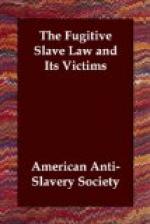Law.” CASTNER HANWAY was of the number.
After suffering imprisonment and being subjected
to great loss of time and heavy expenses, they
were all discharged.
Syracuse, October 1, 1851. JERRY, claimed as the slave of John McReynolds, of Marion County, Missouri, was brought to trial before Commissioner J.F. Sabine. He was rescued by a large body of men from the officers who had him in custody, and was next heard of in Canada.
James R. Lawrence,
a lawyer of Syracuse, acted as counsel
for James Lear,
attorney of McReynolds.
[N.B. Daniel Webster’s prophecy was not fulfilled.]
Columbia, Penn., (fall of 1851.) Man named HENRY, arrested as the slave of Dr. Duvall, of Prince George’s County, Maryland,—taken to Harrisburg, before United States Commissioner McAllister and by him consigned to slavery.
Judge Denning,
of Illinois, discharged a negro brought
before him as a fugitive
slave, on the ground that the
Fugitive Slave Law was
unconstitutional.
Two alleged slaves arrested at Columbia, Penn., on warrant of United States Commissioner McAllister,—claimed as property of W.T. McDermott, of Baltimore. One was carried into slavery, one escaped. (November, 1851.)
Near New Philadelphia, Maryland, a woman, married to a free colored man, with whom she had lived ten years, was arrested as the slave of a Mr. Shreve, of Louisville, Kentucky. She was taken back to Kentucky.
RACHEL PARKER, free colored girl, kidnapped from house of Joseph S. Miller, West Nottingham, Penn., by the “notorious Elkton Kidnapper, McCreary,” Dec. 31, 1851. Mr. Miller tracked the kidnappers to Baltimore, and tried to recover the girl, but in vain. On his way home, he was induced to leave the cars, and was undoubtedly murdered,—it was supposed in revenge of the death of Gorsuch at Christiana. Mr. Miller’s body was found suspended from a tree. A suit was brought in the Circuit Court of Baltimore County, for the freedom of Rachel Parker, Jan. 1853. Over sixty witnesses, from Pennsylvania, attended to testify to her being free-born, and that she was not the person she was claimed to be; although, in great bodily terror, she had, after her capture, confessed herself the alleged slave! So complete and strong was the evidence in her favor, that, after an eight days’ trial, the claimants abandoned the case, and a verdict was rendered for the freedom of Rachel, and also of her sister, Elizabeth Parker, who had been previously kidnapped, and conveyed to New Orleans.
—> McCreary was demanded by Gov. Bigler, of Pennsylvania, to be delivered up for trial on a charge of kidnapping; but Gov. Lowe, of Maryland, refused to surrender him. See Standard, July 2, 1853.




